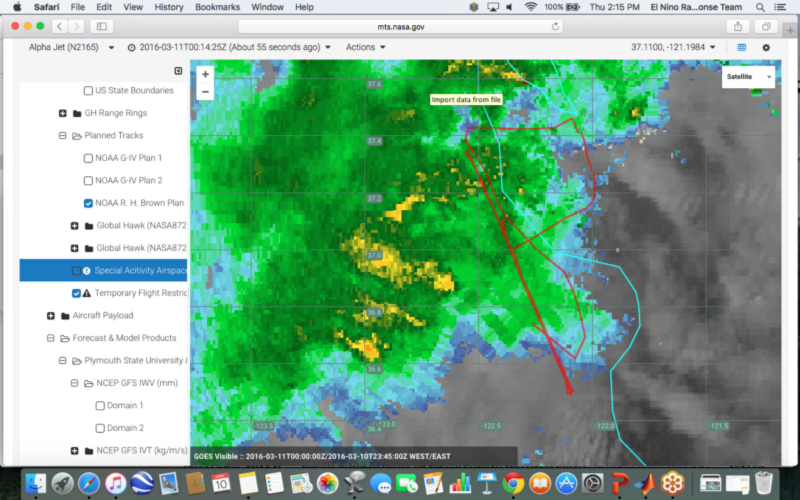G-IV and Alpha Jet Converge on CaliforniaMarch 11, 2016by Ryan Spackman (STC & NOAA)

G-IV and Alpha Jet Converge on California
March 11, 2016by Ryan Spackman (STC & NOAA)
HONOLULU, Hawaii — Today marked an outstanding day for ENRR science, with the third G-IV flight in a series of three flights in five days to observe the cascade of linked dynamical processes between the tropics and extra tropics, culminating in a high-impact precipitation event along the U.S. West Coast:
- Research Flight 20, March 6 — Tropical moisture export survey to the southwest of Hawaii
- Research Flight 21, March 8 — Moisture flux module northeast of Hawaii
- Research Flight 22, March 10 — Five atmospheric river (AR) transects between the subtropics and the Northern California coast
Thanks to a stiff tailwind, today’s flight covered over 3500 nmi of track between Oahu and Ontario CA, with transects across the narrow AR from 16°N to 39°N during the landfalling event in the San Francisco Bay Area (see above). During this science-in-transit flight, we released about 42 dropsondes, with as many as four in the air at any given time. We also acquired stunning data from the Tail Doppler Data across the more northern reaches of the AR.
In concert with the G-IV mission, the Alpha Jet launched from NASA Ames during the afternoon for a 1.5 hour flight offshore and immediately south of San Francisco just as the precipitation was beginning in the Bay Area.
 The Alpha Jet flight track along the California coast during the precipitation event.
The Alpha Jet flight track along the California coast during the precipitation event.
The jet conducted stacked flight legs at about 100, 1000, 8000, and 4000 feet between 5 and 20 nmi offshore to examine coastal barrier jet processes during the landfalling event with a meteorological and trace gas payload. Again, many thanks to our AJAX colleagues who enabled this unique collaboration on extremely short notice.
This marks the conclusion of G-IV research flights from the Pacific theater as part of an extremely productive ENRR field campaign. I know I speak for Randy and the entire science team when I say it has been a sincere pleasure to work with the tireless NOAA-49 crew (and entire AOC team) that adeptly deployed and processed in real time over 625 sondes from 1°S to 39°N latitude in response to the very strong El Niño, and in extraordinary service to the science. The crew is scheduled to transit from Ontario to MacDill AFB in Tampa tomorrow. We wish them a pleasant onward journey back home.
Even with G-IV and Global Hawk science flights now complete, this does not mark the end of ENRR. Our persevering ENRR colleagues continue to launch radiosondes twice daily from Kiritimati through the end of March and up to 8 times daily from the NOAA Ron Brown until the vessel goes into port in San Diego on March 18.
Signing off from Honolulu!
